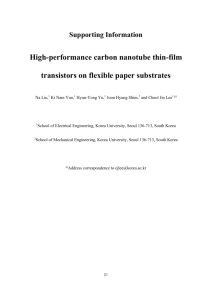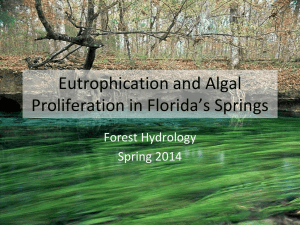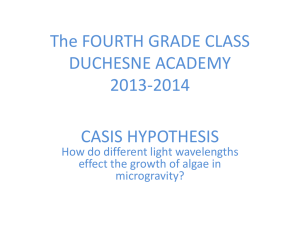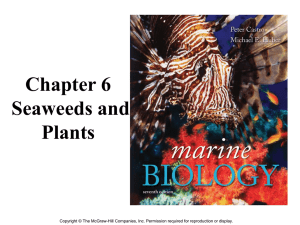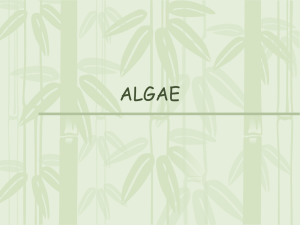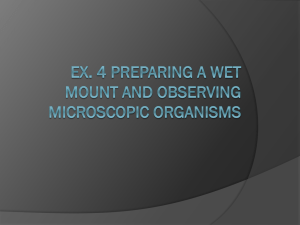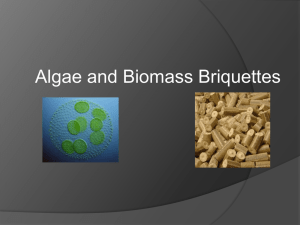Green algae interacting with single-walled carbon
advertisement
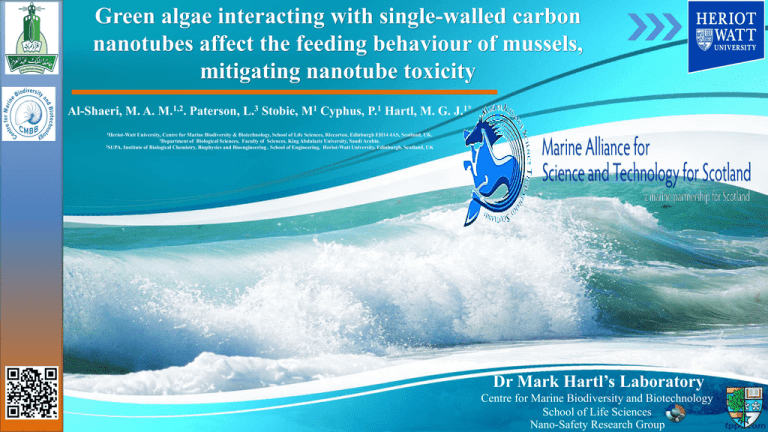
Green algae interacting with single-walled carbon nanotubes affect the feeding behaviour of mussels, mitigating nanotube toxicity Al-Shaeri, M. A. 1,2 M. . Paterson, 3 L. Stobie, 1 M Cyphus, 1 P. Hartl, M. G. 1* J. 1Heriot-Watt University, Centre for Marine Biodiversity & Biotechnology, School of Life Sciences, Riccarton, Edinburgh EH14 4AS, Scotland, UK. 2Department of Biological Sciences, Faculty of Sciences, King Abdulaziz University, Saudi Arabia. 3SUPA. Institute of Biological Chemistry, Biophysics and Bioengineering , School of Engineering, Heriot-Watt University, Edinburgh, Scotland, UK Dr Mark Hartl’s Laboratory Centre for Marine Biodiversity and Biotechnology School of Life Sciences Nano-Safety Research Group 1. Characterization of SWCNTs Introduction Methods •Tetraselmis suecica exposed to SWCNT (diameter 1.1 nm × length 0.5–100µm; Sigma–Aldrich; Fig. 1). •TEM, SEM and Raman spectroscopy and DLS for SWCNT characterization. •Raman spectroscopy, SEM and TEM were used to detect SWCNT-algal interaction. •Flow cytometry used to monitor algal cell viability and algal cell pseudofaeces. •Algal growth and chlorophyll rate determined using an improved Neubauer haemocytometre and fluorometer. •Comet assay used to assess the genotoxicity of SWCNT on mussel in the presence algae •Histological observation was used to determine the trophic transferee of SWCNT from algae to mussel. TEM SEM Fig 1. TEM micrographs of SWCNT stock preparations (1 gL-1 in 0.02% SRNOM) scale bars: 1µm (left); 20nm (right). SEM Fig 4. SEM images of T. suecica from a control sample (a) and from culture medium containing final 500µgL-1 for SWCNTs (b, c and d), which appear surrounded by SWCNT agglomerates. TEM A B C E F SWCNT Results With their high aspect ratio, strength, light weight and electrical conductivity single-walled carbon nanotubes (SWCNTs) provide properties of great interest to industry, and, consequently, are finding use in an ever increasing number of products and applications. The production, use and disposal of SWCNTs will eventually lead to their appearance in the environment [1]. Reported growth inhibition in freshwater algae has been attributed to the agglomeration of CNT on the cells and the associated secondary shading effects [2]. The aims of the present study were to determine the interaction of SWCNTs with marine algae, the effects on viability, growth and chlorophyll rate, as well as whether SWCNTs were able to enter the algal cells; To assess the affect of SWCNTs in the presence and absence algae on the feeding behaviour of mussels as well as and genotoxicity; To assess the transfer trophic of SWCNTs from algae to mussels. 2. Algae-SWCNTs agglomerate Fig 2. Scanning electron microscope images of SWCNT. (a) Crystallized SWNTSRNOM films (b) SEM images of an individual SWCNT. Raman spectroscopy D Breakage in the algal cell wall Plasma membrane damage SWCNTs SWCNTs G-band SWCNTs G+ RBM D-band G- Gˊ-band Fig 5A, B and C: TEM images of control cells with intact cell wall and plasma membrane; Fig 6D ,E and F show cells exposed to 500µgL-1 SWCNTs. Cell wall breakage ; plasmolysis ; internalization of the SWCNTs . Raman spectroscopy Fig 3. Spectrum from SWCNTs stock clearly shows the characteristic peaks of SWCNTs: radial breathing mode (RBM) at 268 cm-1, D band at 1290 cm-1, G band at 1590 cm-1, and Gˊ band at 2585 cm-1. 1590 cm-1 DLS & Zeta potential Table 1. Single-walled carbon nanotube (SWCNT) characterization: Zeta potential SWCNT (µgL-1) apH Zeta potential Zeta potentiala (water) (seawater) 5 –2.95 –8.84 475 10 –4.49 –10.83 1384 50 –7.75 –10.13 1740 100 –5.25 –15.93 4982 500 –6.86 –13.73 6206 8.4, salinity 32 (±1) ‰ DLS= Dynamic light scattering . DLS (nm) 268 cm-1 Zeta potential (%0.02 SRNOM) 1290 cm-1 2585 cm-1 -12.24 Fig 6. Raman spectra of Algal-SWCNT interaction following 24h exposure of algae to SWCNTs (100μL-1). The peaks observed at excitation 785 nm are characteristic of SWCNTs: RBM at 268cm-1, D band at 1290 cm-1, G band at 1590cm-1 and the G’ band at 2585 cm-1. 2 3. Food behaviour of mussels, mitigating nanotube toxicity Algal cell viability 1400 Chlorophyll rate in Tetraselmis suecica Mussel expels SWCNT in the presence of algae 7000 a Expelled SWCNT 5000 Algae 4000 Algae + 500 µg L¯¹ SWCNT Cilia 3000 Epithelium gill control SWCNT 500µg L¯¹ 1000 * 0 * 200 * 0 t₁ t₂ t₃ Time (days) Fig 8. T. suecica were exposed to three replicates of 500µg Lˉ1 SWCNTs. Statistically, there is no significant difference between control and SWCNTs on t0 (P=0.312), however, from 𝑡1 → 𝑡3 were observed there is significant difference (P<0.001) in decreases the rate of chlorophyll. Fig 10. A digital photography camera observed the feeding behaviour of mussels when fed the SWCNTs + algae: (a) mussel starts to expel SWCNTs; long black nanotubes still attached to the inhalant siphon of mussel; (b) the front moves rapidly toward the outside body from 𝑡0 → 𝑡1 approximately 2 min). Algae + 500 µg L¯¹ SWCNT Fig 13. Flow cytometry shows the number of the pseudofaecal algal cells produced by mussels, which have been shown to produce a copious pseudofaecal algal cells in the presence of SWCNTs., Statistically, significantly increased pseudofaeces production (P=0.008) under combined algae and SWCNT exposure. 9 500µgL-1 SWCNTs + Algae (DNA damage in gill) 8 Observation faecal and pseudofaecal algae and SWCNT B 5 4 B 3 C F G D 9 * H I J 100 0 10 50 100 500 Concentration of SWCNT (µgL-1) Fig 9. T. suecica were exposed to SRNOM and SWCNTs at nominal concentrations (5µgLˉ¹, 10µgLˉ¹, 50µgLˉ¹, 100µgLˉ¹, and 500µgLˉ¹) for 8 days. Statistically, there was no significant difference between SRNOM, ≤50µgLˉ¹ SWCNTs and control groups; however, significant growth inhibition occurred ≥100µgLˉ¹ (P<0.001). Fig 11. Feeding behaviour of the mussel. (A,B) Faecal material expelled by the exhalant siphon of the mussel when fed the T. suecica alone. (C) Pseudofaecal material expelled by the inhalant siphon of the mussels when fed the SWCNTs 500µgLˉ¹. (D) Copious pseudofaecal material expelled by the inhalant siphon of the mussel when fed the SWCNTs with T. suecica. 8 * 7 3 4 3 2 0 0 Algae + SWCNTs SWCNT Fig 14. Mussels were fed algae, SWCNT 500µgLˉ¹ alone and algae + SWCNTs for 24h. * significantly different from control, algae and algae + SWCNTs (P<0.001). * 5 1 Algae 500µgL-1 SWCNTs + Algae (B) 6 1 Control Fig 12. Faecal and pseudofaecal algal cells were observed clearly by optical microscopy. (A, B) faecal algal cells in the absence of SWCNTs, (C, D) Pseudofaecal material expelled by the inhalant siphon of the mussels when fed the SWCNTs 500µgLˉ¹ alone, while (E-J) copious pseudofaecal algal cells and SWCNTs expelled by the inhalant siphon of the mussel when fed the SWCNTs with T. suecica. 7 500µgL-1 SWCNTs + Algae (DNA damage in haemocytes) 2 200 * 0 4 * 5 40 0 5 SRNOM 60 20 1 6 400 Digestive algal cells Control Algae Algae + SWCNTs SWCNTs Fig 15. Mussels were fed algae, SWCNT 500µgLˉ¹ alone and algae + SWCNTs for 24h. * significantly different from control, algae and algae + SWCNTs (P<0.001). References [1]Al‐Shaeri, SWCNTs 500µgL-1 SWCNTs + Algae (A) 80 TBARS nMol mg proteinˉ¹ Cells µl-1 d-1 E % DNA in Tail D C 500 300 120 2 Algal growth following 8 days of incubation C B 100 6 A Control * 7 A A Algae mitigates the genotoxicity of SWCNTs SOD % Inhilation tₒ 0 Fig 16. A digital photography-camera correlated with a light microscope shows (E) cilia on the gill epithelia that can be used for capturing food or other substances. (B) control epithelium gill mesh, Figure (C) show the preliminary observation of physical interaction between algae contains SWCNTs and mussels. 2000 Algae 600 C * 6000 Algal cells/ml Chlorophyll rate µg/l 1000 400 Fig 7. Peaks (left) control and (right) 500µgLˉ¹ SWCNT show the viable T. suecica cells using Cyflow. Statistically, there is a significant difference between 500µgLˉ¹ SWCNT and control groups (P<0.001) ANOVA. B A 1200 600 Trophic transfer of SWCNT from algae to mussel b SWCNT 800 Pseudofaeces of algal cells by mussels Majed, et al. "Potentiating toxicological interaction of single‐walled carbon nanotubes with dissolved metals." Environmental Toxicology and Chemistry 32.12 (2013): 2701-2710. [2] Schwab, F., Bucheli, T. D., Lukhele, L. P., Magrez, A., Nowack, B., Sigg, L. & Knauer, K. 2011.Environmental science & technology. Fig 17. The gut from mussels exposed to algal cells-SWCNT 500µg Lˉ¹. Histological sections of the mussel's gut in (A) control tissue, (B) digested algal cells including SWCNTs which have already been shown inside algal cells via TEM , ad (C) SWCNTs in gut. In this assay mussels were left to feed for 10 minutes. Conclusions • SEM confirmed the shading effect of SWCNTs on algal cells (Fig 4). • SWCNTs appeared to be able to enter the algal cells (Fig 5D,E and F). • Control algae remained mitotic, whereas those incubated with SWCNTs (500µgL-1) showed a loss of cellular integrity, indicating irreversible cell damage (Fig 5D). • Raman spectroscopy confirmed SWCNT cover algal cells (Fig 6). • Algal cell viability (Fig 7), Chlorophyll rate (Fig 8) and growth rates (Figure 9) were affected by SWCNTs ≥ 100µgL1. • Mussel can expels a copious pseudofaecal material expelled by the inhalant siphon when fed the SWCNTs with algae (Fig10-12). • The presence of SWCNTs in the food are able to effect the feeding behaviour of mussel (Fig 13). • The toxicity of SWCNTs can be mitigated when mussels fed algae with SWCNTs (Fig 14-15). • SWCNTs are seen able to trophic transfer from alga to mussel (Fig16-17). 3

